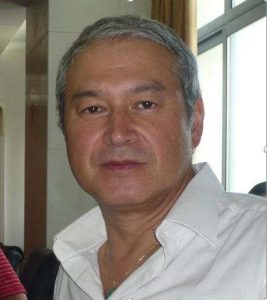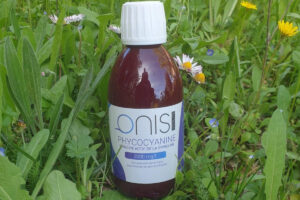
The pigment in Spirulina, C-phycocyanin has exceptional antioxidant properties. It is recommended, in particular, to combat Covid-long.

By Jean-Marc Sabatier*
C-Phycocyanin is a blue pigment found mainly in the spiral microalgae Arthrospira platensis or spirulina (the pigment can also be found, albeit rarely, in certain cyanophyceae microalgae). Spirulina is a microalga made up of cyanobacteria of the Arthospira genus. Cyanobacteria are blue microscopic photosynthetic bacteria. There are some 2,000 species of cyanobacteria, including 36 edible species of the Arthospira genus.
A complex macromolecule
Spirulina is very rich in chlorophyll (a widespread green plant pigment) and phycocyanin (a rare blue cyanobacterial pigment) pigments, hence its blue-green color. Phycocyanin (10-20% of spirulina mass) is one of four known types of phycobiliprotein (along with allophycocyanin, phycoerythrin and phycoerythrocyanin). A phycobiliprotein is a water-soluble photosynthetic compound, formed by the covalent association of an apoprotein and a chromophore (pigment) from the bilin family (bile pigments). Thus, phycocyanin is a complex macromolecule comprising a protein part (high-molecular-weight apoprotein) covalently linked to a chromophore pigment with an open tetra-pyrrolic nucleus. The phycocyanin apoprotein is a heterodimer comprising 2 protein subunits of 15 and 20 kDa.

An anti-aging effect
Phycocyanin has exceptional antioxidant properties, with an antioxidant potential 20 and 16 times more powerful than vitamins C and E respectively.
It is therefore one of the most powerful antioxidants known to date, and is also highly bioavailable, capable of trapping excess reactive oxygen particles-including ROO peroxyl radicals-derived from the oxidation of organic substrates that are highly “deleterious” to the body (phycocyanin’s anti-aging effect).
Phycocyanin also has a beneficial effect on host immunity, stimulating the production and differentiation/maturation of immune cells by our primary/central lymphoid organs (bone marrow and thymus), then secondary (spleen, lymph nodes, and mucosa-associated lymphoid tissue or MALT). Through its action on the bone marrow, it also stimulates the production of megakaryocytes/platelets, which contribute to blood coagulation homeostasis, and red blood cells/red blood cells, which promote oxygen transport in the blood (an activity comparable to that of the hormone erythropoietin or EPO), which is essential for the proper functioning of our cells, tissues and organs.
Recommended against Covid-long
Experimental data show that phycocyanin inhibits overactivation of the renin-angiotensin system (RAS) and its AT1R receptor, thus promoting homeostasis of this physiological endocrine/enzymatic system present throughout the body. Phycocyanin has anti-inflammatory, anti-hypertensive, anti-thrombotic, anti-tumor, anti-oxidant, anti-hypoxic, anti-allergic (including asthma), anti-atherosclerosis, anti-diabetes, anti-dyslipidemia, anti-neurocognitive and digestive disorders, anti-fatigue, anti-aging and detoxifying properties (liver protection and detoxification, chelation of heavy metals, etc.).
Absorption of phycocyanine does not induce side effects in the host, with the exception of very rare mild cases of skin allergy.
*Jean-Marc Sabatier has a PhD in cell biology and microbiology, and an HDR in biochemistry. He is a research director at the CNRS, and is speaking in his own name.
Extract (preview) from the book “Covid Long et effets indésirables du vaccin. Biological mechanisms and promising treatments”, by Jean-Marc Sabatier and Estelle Fougères, published by Editions Trédaniel.
Covid : collection of Jean-Marc Sabatier’s censored articles in English and Spanish